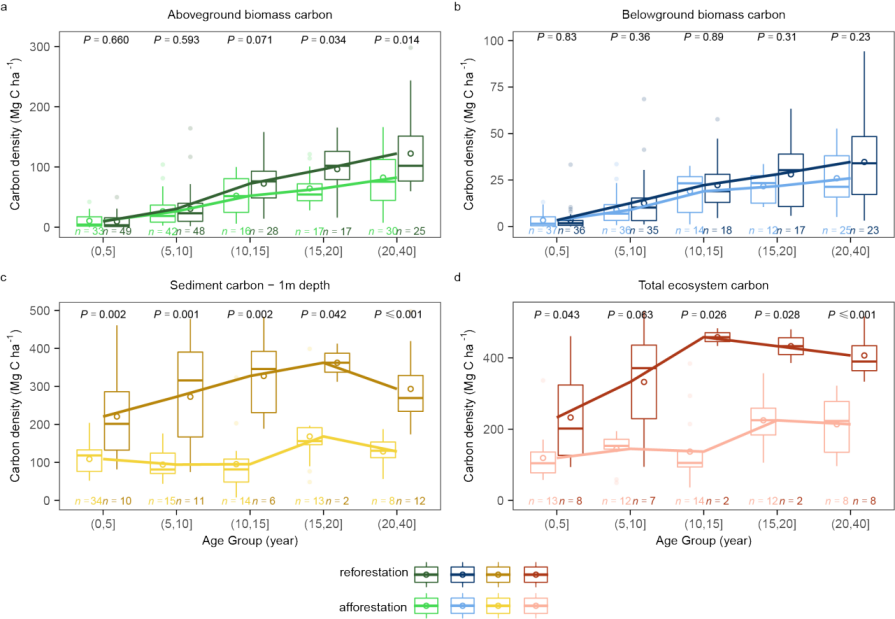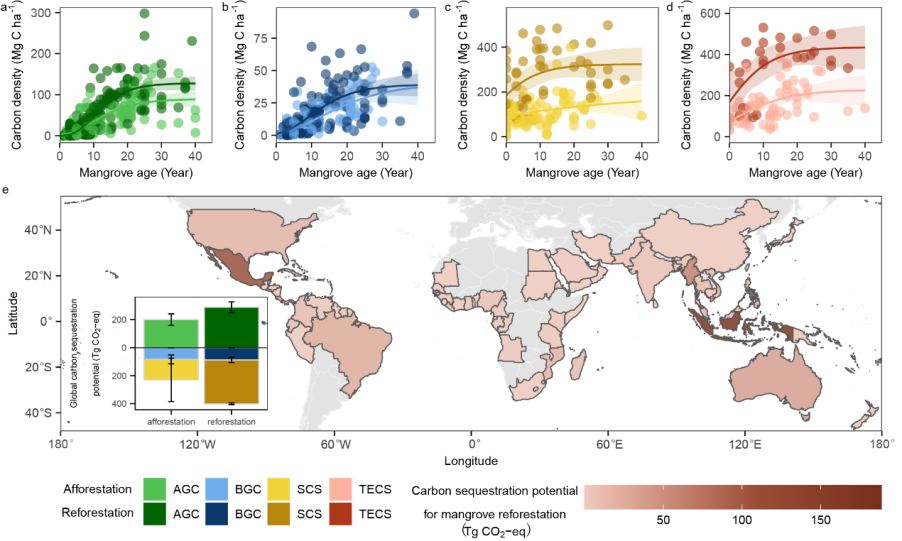Against the backdrops of serious damage to global mangrove ecosystems and decrease of mangrove area year by year, resisting and reversing the loss of mangroves has become a focus of attention of governments and international organizations. The carbon sequestration of mangrove ecosystems per unit area significantly outshines that of nearby forest ecosystems and most inland wetlands, so the protection and restoration project of coastal wetlands such as mangroves is considered to be an extremely important technology for achieving carbon neutrality (that is, blue carbon sink) based on natural solutions to mitigate climate change. However, at present, the comparison of carbon sink strength effects of different mangrove restoration models mainly focuses on the choice of species collocation, planting density, and the choice of artificial planting or other means. Whether different land cover and utilization backgrounds of different restoration areas affect the blue carbon sink strength in afforestation and reforestation and its influencing mechanism are still unclear.
To solve this problem, the research group collected data about the forest age, land use change background and carbon density of 379 mangrove restoration sites around the world to compared and analyze the carbon sequestration and potential influencing factors of mangrove reforestation (areas where original mangroves were lost, such as abandoned fish ponds) and mangrove afforestation (areas without original mangroves, such as tidal flats). The results show that during the 40-year period of mangrove restoration, the blue carbon accumulation per unit area of reforested mangroves in damaged mangrove habitats is significantly higher than that obtained by mangrove afforestation in tidal flats and other areas (Fig. 1).
Meanwhile, based on the data of damaged mangroves and the data of changes in mangrove land use worldwide from 1996 to 2016, reforestation of all physically feasible areas in the deforested mangrove regions of the world could promote the uptake of 671.5–688.8 Tg CO2-eq globally over a 40-year period, 60% more than afforesting the same global area on tidal flats (more marginal sites).

Fig. 1 Comparison of carbon density between mangrove reforestation and afforestation projects over a 40-year period

Fig. 2 Carbon sequestration potential if mangrove afforestation and reforestation projects are implemented globally over a 40-year period.
Based on a comprehensive analysis of many cases and literature data around the world, this study has found that reforestation in damaged mangrove habitats (such as abandoned fish ponds and severely damaged mangroves) can bring higher carbon sequestration benefits than mangrove afforestation, and at the same time reforestation in damaged mangroves can prevent the negative impact of large-scale restoration of mangroves on beaches (foraging habitats for rare birds, etc.). Therefore, global mangrove reforestation should be given priority when designing nature-based solutions in the future. The research results can provide a scientific basis for making mangrove restoration policies, designing restoration projects and protecting mangrove biodiversity to realize carbon neutrality and carbon peaking.
The above research results have been published in Nature Communications, a top international journal, as an article titled “Mangrove reforestation provides greater blue carbon benefit than afforestation for mitigating global climate change”. Song Shanshan, a Class 2020 doctoral candidate of the DESS, Tsinghua University is the first author of the article, and Professor Lin Guanghui, Associate Professor Li Wei and Postdoctoral Fellow Ding Yali of the DESS, Tsinghua University are the corresponding authors. Other co-authors include Professor Neil Saintilan of the School of Natural Sciences, Macquarie University, Australia, Researcher Ken W. Krauss of U.S. Geological Survey, Wetland and Aquatic Research Center, Dr. Stephen Crooks of Silvestrum Climate Associates LLC, USA, Researcher Lv Shuguo of the Institute of Marine Ecology and Environment and Hainan International Blue Carbon Research Center, Hainan Academy of Environmental Sciences, Postdoctoral Fellow Zhou Jian and doctoral candidates Meng Yuchen, Gou Ruikun, Zhang Conghe and Ye Shengbin of the DESS, Tsinghua University. This research has been supported by the National Key R&D Program of China (2019YFA0606604, G.L.), Shenzhen City’s University Stable Support Program (WDZC2020819173345002, G.L.), Tsinghua University Initiative Scientific Research Program (20223080041, W.L.), and Preparation and Pilot Research Program of Hainan International Blue Carbon Research Center (46000022T000000154465, S.L.).
Full-text link: https://www.nature.com/articles/s41467-023-36477-1#Sec14
Written by Song Shanshan